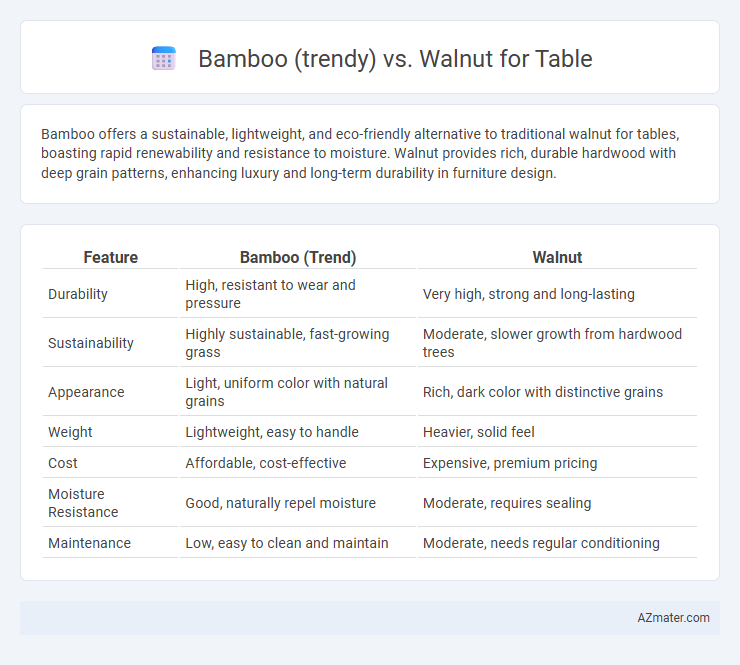Bamboo offers a sustainable, lightweight, and eco-friendly alternative to traditional walnut for tables, boasting rapid renewability and resistance to moisture. Walnut provides rich, durable hardwood with deep grain patterns, enhancing luxury and long-term durability in furniture design.
Table of Comparison
| Feature | Bamboo (Trend) | Walnut |
|---|---|---|
| Durability | High, resistant to wear and pressure | Very high, strong and long-lasting |
| Sustainability | Highly sustainable, fast-growing grass | Moderate, slower growth from hardwood trees |
| Appearance | Light, uniform color with natural grains | Rich, dark color with distinctive grains |
| Weight | Lightweight, easy to handle | Heavier, solid feel |
| Cost | Affordable, cost-effective | Expensive, premium pricing |
| Moisture Resistance | Good, naturally repel moisture | Moderate, requires sealing |
| Maintenance | Low, easy to clean and maintain | Moderate, needs regular conditioning |
Introduction to Bamboo and Walnut Table Trends
Bamboo tables have surged in popularity due to their sustainable, eco-friendly properties and rapid renewability, making them a leading choice in modern, green interior design trends. Walnut tables remain a classic favorite, valued for their rich, dark tones and durable hardwood qualities that offer timeless elegance and long-lasting strength. The trend shows a clear preference for bamboo in contemporary, environmentally conscious spaces, while walnut continues to dominate in traditional and luxurious settings.
Popularity of Bamboo Tables in Modern Interiors
Bamboo tables are increasingly popular in modern interiors due to their eco-friendly nature and rapid renewability compared to traditional hardwoods like walnut. The natural light tone and durability of bamboo complement contemporary minimalist and sustainable design trends, appealing to environmentally conscious consumers. While walnut offers a rich, classic aesthetic, bamboo's affordability and versatility drive its rising demand in urban living spaces.
Walnut Tables: A Classic Choice for Timeless Appeal
Walnut tables offer a rich, deep grain and exceptional durability, making them a classic choice for timeless appeal in furniture design. While bamboo is gaining popularity for its sustainability and modern aesthetic, walnut remains unparalleled for its natural warmth and elegant finish that enhances any interior. Walnut wood's ability to age gracefully ensures that tables crafted from it retain their beauty and value over decades.
Sustainability Comparison: Bamboo vs Walnut
Bamboo tables offer superior sustainability due to bamboo's rapid growth rate, typically maturing in 3-5 years, compared to walnut trees which take 30-40 years to mature. Bamboo's regenerative harvesting process minimizes deforestation and carbon footprint, while walnut requires long-term land use and slower replenishment. Both woods provide durability, but bamboo's eco-friendly cultivation and faster renewability make it the more sustainable choice for table materials.
Durability and Longevity: Which Material Lasts Longer?
Bamboo tables offer exceptional durability due to their high tensile strength and natural resistance to moisture, making them less prone to warping and cracking over time compared to traditional hardwoods. Walnut, known for its dense grain and hardness rating of 1,010 on the Janka scale, provides long-lasting sturdiness and ages beautifully with a rich patina. While walnut boasts superior scratch resistance, bamboo's rapid growth cycle and flexibility contribute to a sustainable yet resilient material, often resulting in comparable or even greater longevity under regular use.
Aesthetic Differences: Bamboo vs Walnut Table Designs
Bamboo table designs showcase a light, natural grain with a smooth, minimalist aesthetic that complements contemporary and eco-friendly interiors. Walnut tables feature rich, deep brown hues with intricate grain patterns, offering a classic, sophisticated look suited for traditional and luxurious spaces. The contrast between bamboo's bright, clean appearance and walnut's warm, textured finish highlights their distinct visual appeals in furniture design.
Price Comparison: Bamboo vs Walnut Tables
Bamboo tables generally cost significantly less than walnut tables, making them a budget-friendly option for sustainable furniture. Walnut tables, prized for their rich grain and durability, command higher prices due to the hardwood's rarity and longer growth cycle. The cost difference often reflects the environmental benefits of bamboo's rapid renewability versus the premium craftsmanship associated with walnut wood.
Maintenance and Care Requirements
Bamboo tables require minimal maintenance due to their natural resistance to moisture and insects, needing only regular dusting and occasional wiping with a damp cloth. Walnut tables demand more care, including periodic oiling or waxing to preserve their rich, dark finish and protect against scratches and water damage. Both materials benefit from avoiding direct sunlight and using coasters, but walnut's dense grain requires more attentive upkeep to maintain its appearance over time.
Environmental Impact and Ethical Sourcing
Bamboo for tables offers a significantly lower environmental impact than walnut, as it grows rapidly and requires minimal water and pesticides, contributing to sustainable forestry and carbon sequestration. Walnut, while prized for its rich aesthetics and durability, has a longer growth cycle leading to more deforestation concerns and higher carbon emissions per harvested tree. Ethically sourced bamboo is often certified by organizations like FSC, ensuring responsible cultivation, whereas ethical walnut sourcing demands strict adherence to forestry regulations and traceability to minimize illegal logging and habitat destruction.
Choosing the Right Table Material for Your Home
Bamboo offers a sustainable, lightweight, and highly durable option for tables, ideal for eco-conscious homeowners seeking a modern aesthetic combined with natural texture. Walnut provides timeless elegance with rich color variations, exceptional durability, and resistance to wear, making it a preferred choice for classic, high-end interiors. When choosing the right table material, consider bamboo for affordability and environmental benefits, while walnut suits spaces prioritizing luxury and long-term value.

Infographic: Bamboo (trend) vs Walnut for Table
 azmater.com
azmater.com